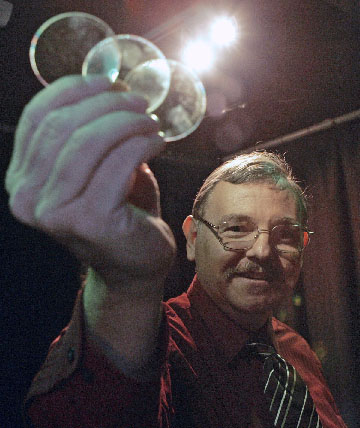By Lisa Y. Garibay
UTEP News Service
Editor’s note: This is the second story in a series highlighting a few of the interdisciplinary research projects at UTEP making an impact in the community, across the region and around the globe.
It all began with a problem, one that Chemistry Professor Carl Dirk, Ph.D., knew he could solve.
The scientist – whose specialty is utilizing the power of computer simulation to perform virtual experiments and solve chemistry-related problems – describes himself as interested in arcane optical processes and materials. Upon reading a white paper from the Getty Conservation Institute several years ago, Dirk realized that this very specific interest could be applied to the institute’s “What if?” list of wishes for safer museum lighting.

“Upon reading the white paper, I realized immediately that one of these wish list ideas that appeared to be impossible was actually achievable,” Dirk said. “I worked out the computational theory for the problem, and Ed Ross, owner of Ross Optical in El Paso, graciously manufactured a prototype filter for free.”
These filters were deployed to the Georgia O’Keeffe Museum in Santa Fe and they enabled a much more extensive display of O’Keeffe’s light sensitive watercolors. They are currently in use on a wider scale by the Getty Conservation Institute, which describes its collaboration with Dirk here.
Dirk’s optical lens filter technology – for which he has received several patents – can be applied to custom-controlled lighting, computer screens, windows and eyeglasses to meet specific requirements of a targeted human need or activity. It has since gone on to contribute to interdisciplinary research collaborations in several biomedical applications, including behavioral data, cognitive testing and collecting biomarker data with professors from chemistry, electrical and computer engineering, physical therapy, health sciences, environmental research and nursing, but it all began with a partnership with one company.
In 2011, scientist Douglas Steel, Ph.D., and businessman Fred Jaeger, owners of Photokinetics, Inc., agreed to start clinical studies in El Paso based on patented and patent-pending research done by Dirk. The company licensed Dirk’s technology from UTEP and is still working with him, most recently on health care-related lighting.
Photokinetics was founded in September 2010 to develop commercial applications and products based on the selective blockage or modification of light that is detected by intrinsically photosensitive Retinal Ganglion Cells (ipRGC) cells in the eye.
ipRGC are suspected or known to influence a number of vital physiological functions including sleep and alertness, migraine headache, photo retinitis, photosensitivity, and a number of photophobias.
Beyond the applications being developed by Photokinetics, Dirk and UTEP’s proprietary technology can be applied in a number of other ways to benefit human health, learning, and well-being. It also has the potential to noninvasively reduce the cost, side effects and usage of conventional pharmacological agents.
Ronnie Stout, director of UTEP’s Center for Simulation, is working on having lighting employing Dirk’s technology installed in one the university’s Nursing Simulator rooms to explore how hospital lighting could bring about health care innovations. The Nursing Simulator’s use of optical filtering may have an impact on the entire industry, create new intellectual property, and provide opportunities for students to become involved in research projects. In addition, it establishes a base for demonstrating the application of this technology to large lighting companies, which can also contribute to raising corporate funding.
PhotoKinetics’ research is also innovative for its exploration of the physiological effects of lighting. Light filtering may prove applicable to a variety of biomedical applications that are in the very early stages of experimentation.
In spring of 2013, Steel reached out once more to UTEP’s Center for Research Entrepreneurship and Innovative Enterprises (CREIE) about exploring other potential areas of collaboration with the university.
“Open communication is leading to synergy and creating many new research opportunities, facilitated by CREIE, and commercialization of research is leading to additional research opportunities,” said Gary Williams, director of CREIE.
Dirk is proud that UTEP’s very first Ph.D. chemistry student, Monica F. Delgado, completed her dissertation with this work.
“Monica was a remarkable student for many reasons, but especially because her undergraduate degree was in aArt, not science,” he said.
Finally, Dirk is proud that this work has spun off into a health care field and may help treat people with certain light-mediated afflictions, while CREIE is encouraged by how much research developed independently in different colleges found common areas of expertise and areas to collaborate.
“We are looking within the UTEP intellectual property portfolio for other collaboration opportunities that will lead to new technologies, new uses, new companies and new jobs,” Williams said.
“University professors can and should try to make contributions not just to scholarship, but also to the economies of their regions and nations,” Dirk said. “Each professor could be the basis for an economic engine with their unique, creative ideas.”